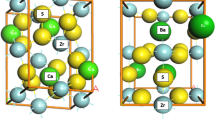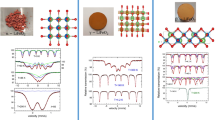Abstract
To investigate the point defect chemistry and the kinetic properties of manganese olivine Mn2SiO4, electrical conductivity (’) of single crystals was measured along either the [100] or the [010] direction. The experiments were carried out at temperatures T=850–1200 °C and oxygen fugacities \(f_{{\text{O}}_{\text{2}} } = 10^{ - 11} - 10^2 \) atm under both Mn oxide (MO) buffered and MnSiO3 (MS) buffered conditions. Under the same thermodynamic conditions, charge transport along [100] is 2.5–3.0 times faster than along [010]. At high oxygen fugacities, the electrical conductivity of samples buffered against MS is ∼1.6 times larger than that of samples buffered against MO; while at low oxygen fugacities, the electrical conductivity is nearly identical for the two buffer cases. The dependencies of electrical conductivity on oxygen fugacity and temperature are essentially the same for conduction along the [100] and [010] directions, as well as for samples coexisting with a solid-state buffer of either MO or MS. Hence, it is proposed that the same conduction mechanisms operate for samples of either orientation in contact with either solid-state buffer.
The electrical conductivity data lie on concave upward curves on a log-log plot of σ vs \(f_{{\text{O}}_{\text{2}} } \), giving rise to two \(f_{{\text{O}}_{\text{2}} } = 10^{ - 11} - 10^2 \) regimes with different oxygen fugacity exponents. In the low-\(f_{{\text{O}}_{\text{2}} } = 10^{ - 11} - 10^2 \) regime \(\left( {f_{{\text{O}}_{\text{2}} } < 10^{ - 7} {\text{atm}}} \right)\), the \(f_{{\text{O}}_{\text{2}} } = 10^{ - 11} - 10^2 \) exponent, m, is 0, the MnSiO3-activity exponent, q, is ∼0, and the activation energy, Q, is 45 kJ/mol. In the high \(f_{{\text{O}}_{\text{2}} } = 10^{ - 11} - 10^2 \) regime \(\left( {f_{{\text{O}}_{\text{2}} } > 10^{ - 7} {\text{atm}}} \right)\), m=1/6, q=1/4–1/3, and Q=45 and 200 kJ/mol for T<1100 °C and T>1100 °C, respectively.
Based on a comparison of experimental data with results from point defect chemistry calculations, it is proposed that the change in m with \(f_{{\text{O}}_{\text{2}} } = 10^{ - 11} - 10^2 \) is induced by a switch in charge neutrality condition. At low \(f_{{\text{O}}_{\text{2}} } = 10^{ - 11} - 10^2 \)s, the charge neutrality condition is [e′]=[Mn {Mn ]; the hopping motion of electron holes h . is the dominant conduction mechanism. At high \(f_{{\text{O}}_{\text{2}} } = 10^{ - 11} - 10^2 \)s, the charge neutrality condition is 2[V ·Mn ]=[Mn · Mn ]; the hopping motion of electron holes h . and the migration of Mn ions associated with a counter flow of divalent Mn vacancies V ·Mn control electrical conduction at T<1100 °C and T>1100 °C, respectively.
Similar content being viewed by others
References
Bai Q, Mackwell SJ, Kohlstedt DL (1991) High-Temperature creep of olivine single crystals 1. mechanical results for buffered samples. J Geophys Res 96:2441–2463
Bai Q, Wang Z-C, Kohlstedt DL (1995a) Manganese olivine II: point defect relaxation. To be submitted to Phys Chem Minerals
Bai Q, Kohlstedt DL, Jin Z-M (1995b) Manganese olivine III: high-temperature creep, in preparation
Constable S, Duba AG (1990) Electrical conductivity of olivine, a dunite, and the mantle. J Geophys Res 95:6967–6978
Coughlin JP (1954) Contributions to the data on theoretical metallurgy: XII. heats and free energies of formation of inorganic oxides. US Bureau of Mines, Bull 542
Duba AG, Schock RN, Arnold EL, Shankland TJ (1990) An apparatus for measurement of electrical conductivity to 1500 °C at known oxygen fugacity. In: The Brittle-Ductile Transformation in Rocks, eds. Duba AG, Durham WB, Handin JW, Wang HF, Geophys Monogr 56, Am Geophys Union, Washington, DC, 207–210
Glasser FP (1958) The system MnO-SiO2. Am J Sci 256:398–412
Greskovich C, Schmalzried H (1970) Nonstoichiometry and electronic defects in Co2SiO4-MgAl2O4 crystalline solutions. J Phys Chem Sol 31:639–646
Hermeling J, Schmalzried H (1984) Tracerdiffusion of the Fe-cations in olivine (FexMg1-x)2SiO4 (III). Phys Chem Minerals 11:161–166
Hirsch LM (1990) Electrical conduction of Co2SiO4. Phys Chem Minerals 17:187–190
Huang JH, Rosén E (1992) Solid state emf studies of equilibria in the Mn-Si-O system at 900 K–1300 K. Scan J Metall 21:116–120
Huang JH, Rosèn E (1994) Determination of Gibbs free energies of formation for the silicates Mn2SiO4 and Mn7SiO12 in the temperature range 1000–1350 K by solid state emf measurements. Phys Chem Minerals 21:228–233
Kingery WD, Bowen HK, Uhlmann DR (1976) Introduction to ceramics. 2nd ed, Wiley, New York
Kröger FA, Vink HJ (1956) Relation between the concentration of imperfections in crystalline solids. In: Solid state physics 3, edited by F Seizte and D Turnbull, pp 307–435, Academic, New York
Morioka M (1983) Cation diffusion in olivine — III. Mn2SiO4 system. Geochim Cosmochim Acta 47:2275–2279
Muan A (1959) Phase equilibria in the system manganese oxide — SiO2 in air. Am J Sci 257:297–315
Nakamura A, Schmalzried H (1983) On the nonstoichiometry and point defects of olivine. Phys Chem Minerals 10:27–37
Press WH, Flannery BP, Teukolsky SA, Vetterling WT (1986) Numerical recipes: the art of scientific computing, Cambridge University Press, 818 pp
Robie RA, Hemingway BS, Fisher JR (1979) Thermodynamic properties of minerals and related substances at 298.15 K and 1 bar (105 Pascal) pressure and at higher temperatures. US Geo Surv Bull 1452
Schmalzried H (1981) Solid State Reactions, 254 pp, Academic, San Diego, California
Schock RN, Duba AG (1985) Point defects and the mechanisms of electrical conduction in olivine. In: Point Defects in Minerals, ed. Schock RN, Geophys Monogr 31. Am Geophys Union, Washington, DC, 88–96
Schock RN, Duba AG, Shankland TJ (1989) Electrical conduction in olivine. J Geophys Res 94:5829–5839
Schwier G, Dieckmann R, Schmalzried H (1973) Punktfehlstellen in Oxidmischphasen (i), Fehlstellenthermodynamik der Mischphasen (CoxMg1 — x)O und (CoxMg1 — x)2SiO4. Ber Bunsenges Phys Chem 77:402–408
Sockel HG (1974) Defect structure and electrical conductivity of crystalline ferrous silicate. In: Defects and transport in oxides, eds. Schmelzer NS, Jaffe RJ. Plenum Press, New York, 341–355
Takei H (1976) Czochralski growth of Mn2SiO4 (tephroite) single crystal and its properties. J Cryst Growth 34:125–131
Tozer DC (1979) The interpretation of upper-mantle electrical conductivities. Tectonophys 56:147–163
Tuller HL (1985) Electrical conduction in ceramics: Toward improved defect interpretation. In: Point Defects in Minerals, ed. Schock RN, Geophys Monogr 31. Am Geophys Union, Washington, DC, 47–68
Wanamaker BJ, Duba AG (1993) Electrical conductivity of San Carlos olivine along [100] under oxygen- and pyroxene-buffered conditions and implications for defect equilibria. J Geophys Res 98:489–500
Windhager HJ, Borchardt G (1975) Tracerdiffusion und Fehlordnung in dem Orthosilikat Co2SiO4. Ber Bunsenges Phys Chem 79:1115–1119
Author information
Authors and Affiliations
Rights and permissions
About this article
Cite this article
Bai, Q., Wang, Z.C. & Kohlstedt, D.L. Manganese olivine I: Electrical conductivity. Phys Chem Minerals 22, 489–503 (1995). https://doi.org/10.1007/BF00209374
Received:
Revised:
Accepted:
Issue Date:
DOI: https://doi.org/10.1007/BF00209374




